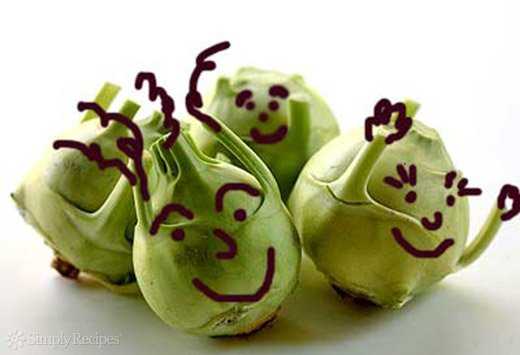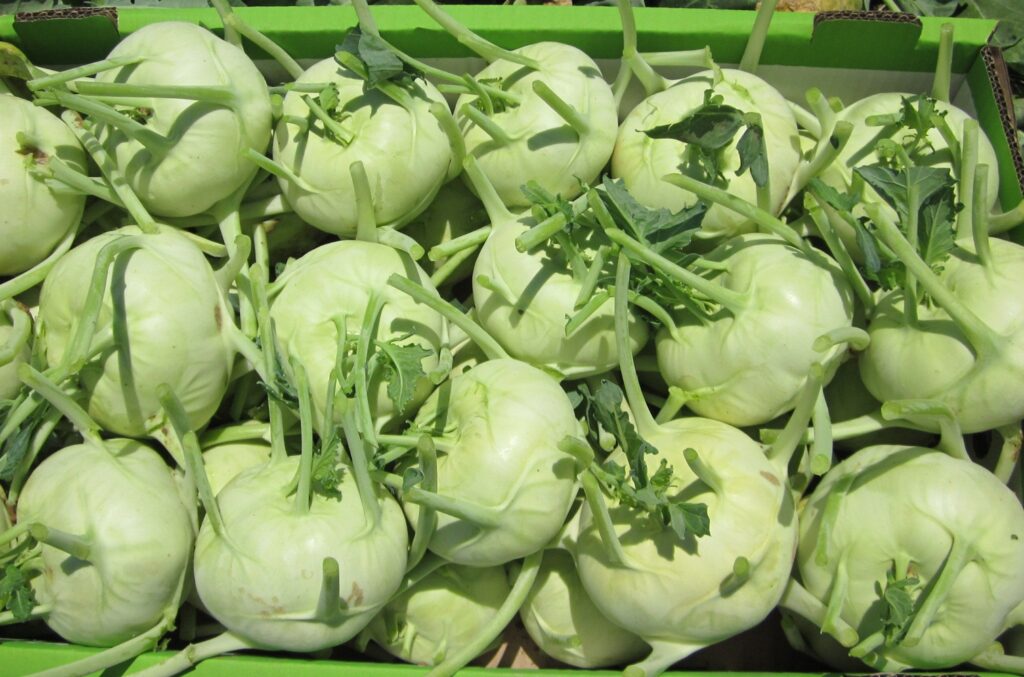
DELIVERY CHANGES FOR THE PURIM FESTIVAL NEXT MONDAY:
Monday (March 25th) deliveries to Jerusalem, Modi’in and the Mevaseret Tzion area will be moved to Tuesday. Deliveries in Tel Aviv, Ramat Gan, Givataim, Kiryat Ono, Rishon Letzion, Nes Tziona, Rechovot and Mazkeret Batia remain as usual.
May this Purim be a joyous festival that brings good tidings and transforms mourning to celebration!
____________________________________________________
Often kohlrabi is likened to an alien, perhaps due to its green color and outreached arms. Indeed, our friend sports a rather exceptional shape, perhaps because he is an unconventional phenomenon in the vegetable world. We know many vegetables that are the fruit of the plant (tomato, cucumber, pumpkin, pepper, etc.,) or the leaves (Swiss chard, cabbage, kale, arugula, parsley, and more) or the flowers (broccoli and cauliflower) and even the roots (beets, sweet potatoes, radishes and carrots). But our kohlrabi star is a stem. It never grew underground and is not a root. In fact, it is the lower part of the plant’s stem that has thickened and rounded. Very rare indeed…This rarity is shared by only two other vegetables, from other families: the celery and the fennel. But those two are part of an entirely different story.
Kohlrabi is the son of a prominent, longstanding family, the Brassicaceae’s, which count among their members such well-loved vegetables as the cabbage, broccoli, cauliflower, kale and Brussels sprout. Though these family members hog the spotlight, the bashful kohlrabi is a delicious veggie who shines bright in the medicinal value department.
At the start of its growth, the kohlrabi plant resembles a cauliflower, cabbage, broccoli or kale plant. It sprouts lovely green leaves on an upright stem. But upon maturity, the kohlrabi searches for its own individual identity. Suddenly its stalk thickens, curves up and becomes ball-shaped until a round kohlrabi sits upon the earth (not under it!), light green (or purple, depending upon the variety), sweet and juicy.
The origin of its name derives from German: kohl=cabbage, rabi=turnip. But it isn’t really a hybrid of the two. The name was given perhaps because of the vegetable’s cabbage family lineage, but resembles a plump turnip by shape. But that too is misleading, because the kohlrabi, as mentioned, is neither a root nor tuber, but rather a thickened stem.

The geographic distances the kohlrabi has traversed over the years could outshine the most frequent flyer. Like the rest of its family, the kohlrabi’s ancestor is the wild cabbage, or leafy cabbage, whose origins are quite ancient. Already in the first century, Roman agronomists and cooks wrote about it. Charlemagne, the first Holy Roman emperor, ordered that kohlrabi be planted in his kingdom. From Europe it traveled to far-distant North India in the 17thcentury, becoming a main component of the Hindu diet. From there, our vegetable migrated to Northern Africa, the Middle East, China and Africa, and later to the United States–mainly to the Southern kitchen. To this day, kohlrabi is a big star in Indian, Asian, German and Hungarian cookbooks.
The kohlrabi is speedier to ripen than the rest of his family, because to reach the edible part we don’t have to wait for the plant to bloom (like the cauliflower or broccoli) or for the leaves to close (like the cabbage.) In fact, kohlrabi should be picked early, before it has matured. A big kohlrabi means it was picked too late, and its texture is liable to be “woody” and fibrous. This is also the reason your Chubeza box occasionally brings you tiny kohlrabies. A harshly cold winter can stunt the kohlrabi’s growth, yet an extended wait for a Spring growth spurt can harm its juicy, crispy texture, which is why we pick them small. The good news is that small-sized kohlrabis do not have to be peeled, thanks to their soft, delicate skin.
Kohlrabi can be eaten in virtually any form. It is customary to eat it raw, but it’s delicious grilled, oven-roasted, or on an outdoor grill. It is super tasty when cooked or steamed, not only in soup, but stir-fried in butter or baked with salt, white pepper and sage. Kohlrabi can even be pickled. In Chinese-food recipes, it can substitute for radish or turnips and for water chestnuts. Its greens taste like kale and can be used similarly and added to soup, pasta sauces and stir-fries. Take a peek at our recipe section to get ideas of non-conventional ways to use kohlrabi.
Health-wise, the kohlrabi possesses all the medicinal virtues of the Brassicaceae family. It is an outstanding source of Vitamin C (one cup of sliced kohlrabi supplies the recommended daily portion), and like the cauliflower, is a great source of dietary fiber. Kohlrabi also contains high levels of potassium, folic acid and calcium. In folk medicine it is considered to cleanse the blood and kidneys, as well as being beneficial for the lymphatic system and for digestion. Nissim Krispil writes of Moroccan Jews who make kohlrabi and honey juice to remedy hoarseness and excess phlegm. In natural medicine, kohlrabi is mixed with other vegetables to make a juice that treats asthma, improves lung function, sinus issues and thyroid function. Adding carrot juice will improve and quaff the taste of kohlrabi juice.
The kohlrabi is picked young, in some seasons less than two months after being planted. But it is, in fact, a biennial vegetable, meaning that to arrive at a complete growth cycle climaxed by seed production, it must go through two growing seasons. In between is a rest period, or “incubation,” after which it will flower and produce seeds the following springtime.
Being a winter vegetable, kohlrabi favors a cool climate. We try to extend the season as much as possible and begin planting it at the end of August. But we’re always plagued by doubts whether it’s the right time, as the first round of kohlrabi in our fields can find itself struggling to battle the end of summer heat. When the poor vegetable suffers heat stress, it is vulnerable to insects and other blights. In particular, the tobacco moth, a tiny, most annoying aphid, just loves climbing all over kohlrabi plants.
Actually, her special passion is for the brassicas, literally suffocating them with love. The tobacco moth and countless members of her highly-extended family sit on the vegetable plants’ leaves and literally blacken them. This pest feeds on the plant and weakens it, while secreting large quantities of honeydew, a sticky sugary substance that attracts the sooty mold fungi, covering the leaves in black and decreases their ability to photosynthesize. When this damages the kohlrabi, the result is white tasteless fruit and a markedly small crop yield. (Very thankfully, we did not encounter such a situation this year…)
The good news is that as the temperatures plunge, the destructive moth becomes lethargic, thus the later-growing kohlrabi rounds are much less infested. Our little friend must now be snuggling tight under its winter slumber covers. The current kohlrabi harvest is quite fine, yielding green, juicy, delicious fruit. This is the present harvest of our cool-rabi, so give it due respect and a place of honor on your plates as this super veggie delights your palate and heart.
Hoping for good news this week. May the Purim festival bring a nahafochu to turn fears and tension into joy, with the return of the hostages to their homes.
Alon, Bat-Ami, Dror, Orin and the entire Chubeza team
WHAT’S IN THIS WEEK’S BOXES?
Monday: Swiss chard/kale/beets/New Zealand spinach, carrots, lettuce, kohlrabi, potatoes, celeriac/celery stalk/parsley root, cabbage/sweet potatoes, parsley/coriander/dill, tomatoes, cucumbers, leeks/onions.
Large box, in addition: Fava beans/snow peas or garden peas/Jerusalem artichokes, cauliflower/broccoli, turnips.
FRUIT BOXES: Bananas, oranges/clementinas, avocados, red apples, pomelit. Free gift for all: lemons!
Wednesday: Swiss chard/kale/bunched beets with greens, carrots, lettuce, kohlrabi, potatoes, celeriac/celery stalk/parsley root, cabbage/sweet potatoes, parsley/coriander/dill, tomatoes, cucumbers, leeks/onions.
Large box, in addition: Fava beans/snow peas/Jerusalem artichokes, turnips/daikon/red sweet pepper, scallions.
FRUIT BOXES: Bananas, oranges, avocados, red apples, pomelit/red grapefruit. Free gift for all: lemons!


